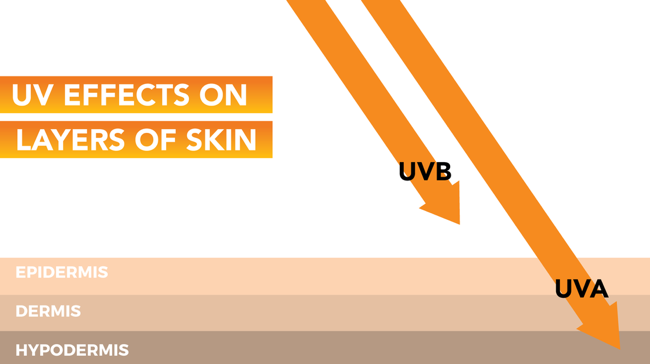Sunscreen or sunblock is used to protect the skin from excess UV exposure, which can cause various types of skin cancer. There are two main types of UV radiation that affects the skin: UVA and UVB radiation. The former has the longest wavelength and penetrates deeper into the epidermis of the skin and is able to reach the dermis where the living skin cells are present.

UV Damage on the Skin
UVA radiation may result in skin conditions such as loose skin, sun spots and can also affect the DNA which increases the risk of cancer. It causes oxidative stress by activating the endogenous photosensitizers which may indirectly lead to DNA damage and long-term photoaging.
UVB radiation, on the other hand, reaches the superficial layers of the skin and mainly causes redness, sun burn and also skin cancer. UVB rays can directly damage DNA and proteins in the skin cells of the epidermis and is linked to erythema or sunburn. Both UVA and UVB radiation suppresses the immune system, which is associated with the development of skin cancers and may contribute to the development of melanoma.
Also, UV radiation signal the skin cells to produce more melanin to try to protect the skin from burning or damaging the skin. This overproduction of melanin results in pigmentation problems at different areas of the skin which is in contact with the sun, resulting in uneven skin tone. Sunscreens are therefore used as a form of protection to reduce or prevent such skin issues.
Sunscreen Ingredients & How they protect the skin?
Up to date, the Food and Drug Administration (FDA) has approved 17 active ingredients for use in sunscreens. Chemical and physical sunscreen ingredients may be used to help protect the skin from UV damage. Physical sunscreen products make use of titanium dioxide and zinc oxide as a physical barrier to reflect and scatter the UV rays from the skin surface. They typically appear white and opaque and is unfavourable by many consumers.
Chemical sunscreen ingredients, on the other hand, are able to absorb the UV radiation and dissipate the energy into another form. Examples are oxybenzone, octyl methoxycinnamate, avobenzene and many more. Sunscreens with these chemical actives are usually colourless or translucent to give a more favourable appearance and consumer experience.
Sun Protection Factor (SPF) primarily measures the ability to block the skin’s response to UVB radiation. The American Academy of Dermatology (AAD) came up with an analogy to make SPF easier to understand to a consumer: “When using a SPF of 15, a fair-skinned person who normally sunburns in 20 minutes of midday sun exposure may tolerate 15 times 20 minutes (300 minutes) without burning”. To quantify SPF values, SPF of 15 blocks out 94% of UVB rays, SPF 30 blocks out 97% of UVB rays and SPF 50 blocks out 98% of UVB rays.
Consumers also do not use the appropriate amount of sunscreen per area to achieve the specific SPF value as claimed on the products. The internationally agreed application amount is 2 mg/cm2, but consumers only apply between 0.5 and 1.5 mg/cm2. Therefore, they do not get the full protection as expected and still may experience sunburn or other types of skin cancers.
How The Lightening Serum reverses the sun’s damage on the skin?
The Lightening Serum by 28cubed acts on the “excited” skin cells which are activated by UV radiation and calms it down by signalling the cells to produce less of this excess melanin, with the combination of Po3™. Once the dermis layer produces melanocytes with less melanin, the new cells are revealed on the top-most layer of the skin once the dead skin cells are shed. This way, The Lightening Serum keeps the skin cells from being agitated from any UV radiation.
Find out more about how The Lightening Serum uses food science technology to help you achieve brighter, more even and younger looking skin here.
